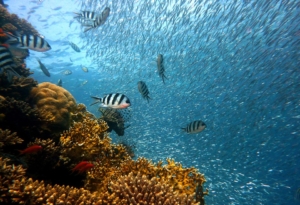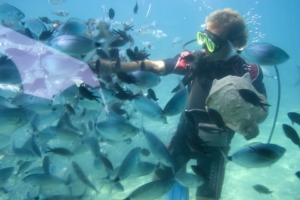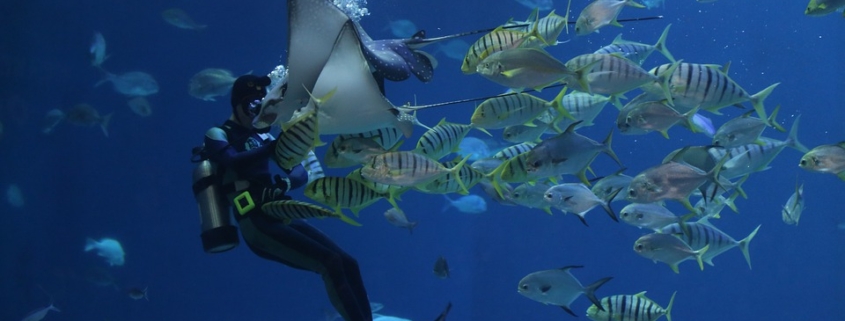While the exact number is unknown, marine biologists estimate there to be over 33,000 species of fish in the ocean. Regardless of where you are diving, you’ll probably encounter some of these fish. With so many different species, however, you may struggle to correctly identify them. The good news is there are ways to improve your fish-identification skills.
Takes Photos… Lots of Photos
Don’t forget to bring a waterproof camera so that you can take photos of all the fish, as well as other marine life, that you encounter while diving. Without a camera, you’ll only your memory to go by. You may remember some of the fish from your dive, but you probably won’t remember them all. A waterproof camera allows you to capture photos of fish for future reference purposes. When you come across an unfamiliar fish, point your camera in its direction and take a photo. After making your way back to your home or hotel, you can then research fishes with a similar appearance.
For the best photos possible, try shooting up at the fish rather than down. In other words, you should position yourself over the fish to take a photo. If you’re forced to shoot up, the fish’s silhouette may look distorted, in which case the photo won’t be of much use. Of course, you won’t always have the luxury of positioning yourself over a fish to take a photo. If the fish is swimming fast and you’re directly below, your only option may be to take to a photo from below — and that’s okay. When given the option, though, point your camera up at the fish rather than down. Doing so will help you take clearer and more detailed photos that you can use to identify fish.
Observe Behaviors
 Taking photos of fish can certainly help, but you should also observe their behaviors. Like with other animals, different types of fish exhibit different behaviors. Groupers, for example, are solitary fish that prefer traveling alone. As a result, you typically won’t see them swimming together. Flounders, on the other hand, stay at or near the ocean floor where they hunt for other small fish or shrimp to eat. Flounders are also very skittish. If you approach a flounder while diving, it will probably skitter in the opposite direction while kicking up a cloud of sediment in its wake.
Taking photos of fish can certainly help, but you should also observe their behaviors. Like with other animals, different types of fish exhibit different behaviors. Groupers, for example, are solitary fish that prefer traveling alone. As a result, you typically won’t see them swimming together. Flounders, on the other hand, stay at or near the ocean floor where they hunt for other small fish or shrimp to eat. Flounders are also very skittish. If you approach a flounder while diving, it will probably skitter in the opposite direction while kicking up a cloud of sediment in its wake.
No two types of fish exhibit the exact same behaviors. By observing the behaviors of fish, you’ll have a better shot at identifying them.
Here are some of the different types of behaviors to look for while diving:
- Swimming speed
- Depth
- Activity
- Size of school or shoal
- Solitary
- Feeding
- Natural defense mechanism
- Reproduction
Record Fish Encounters in a Dive Log
You might be surprised to learn that dive logs can help you identify fish. Some people assume that dive logs are only used to record information about diving conditions, but this isn’t true. You can use them to record any relevant or meaningful information about a dive, including fish encounters. Most dive logs feature a comments section where you can record information such as this. Typically found towards the end of a dive log, it’s a highly useful section for keeping track of fish encounters.
When diving, take a mental note of all the fish you see. Even if you don’t know what species a particular fish it, you can make a mental note of its appearance and behavior. After resurfacing from the dive, fill in the comments section with information about the fish. Maybe you recall seeing large groupers traversing a local reef, or perhaps you encountered a school of parrotfish. By recording these fish encounters in a dive log, you’ll have a better chance at properly identifying them.
Keep in mind, you can include other information about the dive in the comments section as well. Unlike other sections of a dive log, the comments section can be used for any relevant or meaning information about a dive. If you felt uncomfortably cold, for instance, you may want to mention this in the comments section so that you can wear a thicker and better-insulated wetsuit the next time you go diving in similar conditions.
Ask Your Divemaster
If you’re struggling to identify a particular fish, ask your divemaster. Divemasters have firsthand knowledge of native fish in the surrounding waters. After performing dozens or even hundreds of dives, they become familiar with the native fish. As a result, your divemaster can help you identify fish. When you come across an unfamiliar fish, ask your divemaster what he or she thinks it is.
Research Fish Online
With a little bit of online research, you can typically identify fish. If you record your fish encounters in a dive log, you should be able to look them up online. There are several ways to research fish online, one of which is to use the Google Images reverse image search feature. As the name suggests, this feature allows you to search for the same or related images on Google. If you have a photo of an unknown fish, Google Images will reveal similar images, some of which may contain the fish’s name.
To perform a reverse image search on Google Images, head over to images.google.com on your desktop computer and click the camera icon to the right of the search box. Next, select “Upload an image,” followed by “Browse.” You can then navigate the image’s location on your computer. Once the image has finished uploading, Google Images will reveal search listings for similar images, which may help you identify the depicted fish.
Pick Up a Fish Identification Book
 There are books available that can help you identify fish. Known as a fish identification book, it’s an invaluable resource for serious divers. The Caribbean Reef Life Fish ID Book sold here at Dive Logz contains hundreds of reef-dwelling fish. In this fish identification book, you’ll find descriptions of fish as well as their growth patterns, life stages and more.
There are books available that can help you identify fish. Known as a fish identification book, it’s an invaluable resource for serious divers. The Caribbean Reef Life Fish ID Book sold here at Dive Logz contains hundreds of reef-dwelling fish. In this fish identification book, you’ll find descriptions of fish as well as their growth patterns, life stages and more.
The Caribbean Reef Life Fish ID Book includes information on all types of reef-dwelling marine life. In addition to fish, this book will teach you about plants, sponges, turtles and even marine mammals. If you’re planning to dive in the Caribbean in the near future, remember to pick up a copy of the Caribbean Reef Life Fish ID Book. After you’ve finished diving, you can cross-reference your dive log memos and fish photos with the fish described in this book.
Enroll in the PADI Fish Identification Course
The Professional Association of Diving Instructors (PADI) offers a course that’s designed specifically for fish identification. Available to all divers 10 years of age or older who’ve completed the Open Water Diver course or higher, it’s well worth the investment of your time and money if you’re serious about fish identification. During this course, you’ll learn how to identify native fish, fish surveying methods, and how to protect fish and other marine life.
You can learn more about the PADI Fish Identification course by visiting the official PADI website here.
The Caribbean Fish I.D Book is the only book one in existence, with it, you can identify some of the ocean life you come across on your dives!



